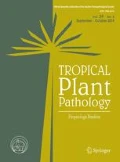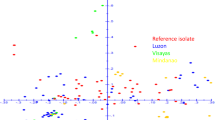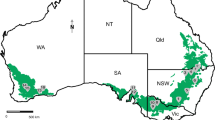Abstract
Blast is a major disease of rice in Brazil, the largest rice-producing country outside Asia. This study aimed to assess the genetic structure and mating-type frequency in a contemporary Pyricularia oryzae population, which caused widespread epidemics during the 2012/13 season in the Brazilian lowland subtropical region. Symptomatic leaves and panicles were sampled at flooded rice fields in the states of Rio Grande do Sul (RS, 34 fields) and Santa Catarina (SC, 21 fields). The polymorphism at ten simple sequence repeats (SSR or microsatellite) loci and the presence of MAT1-1 or MAT1-2 idiomorphs were assessed in a population comprised of 187 isolates. Only the MAT1-2 idiomorph was found and 162 genotypes were identified by the SSR analysis. A discriminant analysis of principal components (DAPC) of SSR data resolved four genetic groups, which were strongly associated with the cultivar of origin of the isolates. There was high level of genotypic diversity and moderate level of gene diversity regardless whether isolates were grouped in subpopulations based on geographic region, cultivar host or cultivar within region. While regional subpopulations were weakly differentiated, high genetic differentiation was found among subpopulations comprised of isolates from different cultivars. The data suggest that the rice blast pathogen population in southern Brazil is comprised of clonal lineages that are adapting to specific cultivar hosts. Farmers should avoid the use of susceptible cultivars over large areas and breeders should focus at enlarging the genetic basis of new cultivars.



Similar content being viewed by others
References
Adreit H, Santoso AD, Utami DW, Notteghem JL, Lebrun MH, Tharreau D (2007) Microsatellite markers for population studies of the rice blast fungus. Magnaporthe grisea. Mol Ecol Notes 7:667–670
Anmarkrud JA, Kleven O, Bachmann L, Lifjeld JT (2008) Microsatellite evolution: mutations, sequence variation, and homoplasy in the hypervariable avian microsatellite locus HrU10. BMC Evol Biol 8:138. doi:10.1186/1471-2148-8-138
Bruvo R, Michiel NK, D’Souza TG, Schulenburg H (2004) A simple method for the calculation of microsatellite genotype distances irrespective of ploidy level. Mol Ecol 13:2101–2106
Castroagudín VL, Ceresini PC, Oliveira SC, Reges JTA, Maciel JLN, Bonato ALV, Dorigan AF, McDonald BA (2015) Resistance to QoI fungicides is widespread in Brazilian populations of the wheat blast pathogen Magnaporthe oryzae. Phytopathology 105:284–294
Clarkson JP, Coventry E, Kitchen J, Carter HE, Whipps JM (2013) Population structure of Sclerotinia sclerotiorum in crop and wild hosts in the UK. Plant Pathol 62:309–324
CONAB (2016) Companhia Nacional de Abastecimento. Arroz. Safra de 2015/2016. Sexto Levantamento, março de 2016. URL: http:www.conab.gov.br
Consolo VF, Cordo CA, Salerno GL (2005) Mating-type distribution and fertility status in Magnaporthe grisea populations from Argentina. Mycopathologia 160:285–290
Consolo VF, Cordo CA, Salerno GL (2008) DNA fingerprint and pathotype diversity of Pyricularia oryzae populations from Argentina. Australas Plant Pathol 37:357–364
Dellaporta SL, Wood J, Hicks JB (1983) A plant DNA minipreparation version II. Plant Mol Biol Report 1:19–21
Excoffier L, Lischer HE (2010) Arlequin suite ver 3.5: a new series of programs to perform population genetics analyses under Linux and Windows. Mol Ecol Resour 10:564–567
Gonçalves FJ, Filippi MCC, Silva Lobo VL, Araújo LG, Silva GB, Guedes Coelho AS, Prabhu AS (2016) Polymorphism detection by microsatellite markers in a Magnaporthe oryzae population from different geographical areas of Brazil. J Phytopathol. doi:10.1111/jph.12485
Jombart T (2008) Adegenet: a R package for the multivariate analysis of genetic markers. Bioinformatics 24:1403–1405
Jombart T, Devillard S, Balloux F (2010) Discriminant analysis of principal components: a new method for the analysis of genetically structured populations. BMC Genet 11:1–15
Kalinowski ST (2005) HP RARE 1.0: a computer program for performing rarefaction on measures of allelic richness. Mol Ecol Notes 5:187–189
Kamvar ZN, Tabima JF, Grunwald NJ (2014) POPPR: an R package for genetic analysis of populations with clonal, partially clonal, and/or sexual reproduction. PeerJ 2, e281
Kaye C, Milazzo J, Rozenfeld S, Lebrun MH, Tharreau D (2003) The development of simple sequence repeat markers for Magnaporthe grisea and their integration into an established genetic linkage map. Fungal Genet Biol 40:207–214
Lehner MS, Paula Júnior TJ, Hora Júnior BT, Teixeira H, Vieira RF, Carneiro JES, Mizubuti ESG (2015) Low genetic variability in Sclerotinia sclerotiorum populations from common bean fields in Minas Gerais State, Brazil, at regional, local and micro-scales. Plant Pathol 64:921–931
Leung H, Bonomeo ES, Bernardo MA, Notteghem TL (1988) Genetic analysis of virulence in the rice blast fungus Magnaporthe grisea. Phytopathology 78:1227–1233
Levy M, Romao J, Marchetti MA, Hamer JE (1991) DNA fingerprint with a dispersed repeated sequence resolves pathotype diversity in the rice blast fungus. Plant Cell 3:95–102
Levy M, Correa-Victoria FS, Zeigler RS, Xu S, Hamer JE (1993) Genetic diversity of the rice blast fungus in a disease nursery in Colombia. Phytopathology 83:1427–1433
Li YC, Korol AB, Fahima T, Beiles A, Nevo E (2002) Microsatellites: genomic distribution, putative functions and mutational mechanisms: a review. Mol Ecol 11:2453–2465
Maciel JL, Rodrigues PC, Avozani OA, Moraes MG (2004) Padrão molecular e de virulência de isolados de Pyricularia grisea do Estado do Rio Grande do Sul. Fitopatol Bras 29:504–510
Maciel JL, Ceresini PC, Castroagudin VL, Kema GHJ, McDonald BA (2014) Population structure and pathotype diversity of the wheat blast pathogen Magnaporthe oryzae 25 years after its emergence in Brazil. Phytopathology 104:95–107
McDonald BA, Linde C (2002) Pathogen population genetics, evolutionary potential, and durable resistance. Annu Rev Phytopathol 40:349–379
Meirmans PG, Van Tienderen PH (2004) GENOTYPE and GENODIVE: two programs for the analysis of genetic diversity of asexual organisms. Mol Ecol Notes 4:792–794
Milgroom MG (2015) Population biology of plant pathogens genetics, ecology, and evolution. Cornell University, Ithaca, New York. The American Phytopathological Society
Nei M (1973) Analysis of gene diversity in subdivided populations. Proc Natl Acad Sci U S A 70:3321–3323
Notteghem JL, Silué D (1992) Distribution of the mating type alleles in Magnaporthe grisea populations pathogenic on rice. Phytopathology 82:421–424
Park SY, Milgroom MG, Han SS, Kang S, Lee YH (2003) Diversity of pathotypes and DNA fingerprint haplotypes in populations of Magnaporthe grisea in Korea over two decades. Phytopathology 93:1378–1385
Park SY, Milgroom MG, Han SS, Kang S, Lee YH (2008) Genetic differentiation of Magnaporthe oryzae populations from scouting plots and commercial rice fields in Korea. Phytopathology 98:436–442
Peever TL, Olsen L, Ibáñez A, Timmer LW (2000) Genetic differentiation and host specificity among populations of Alternaria spp. causing brown spot of grapefruit and tangerine x grapefruit hybrids in Florida. Phytopathology 90:407–414
Peixoto LF (2014) Identificação da compatibilidade, sexualidade, fertilidade e AVR1-CO39 em populações de Magnaporthe aryzae coletadas em lavouras de arroz no Brasil: Universidade Federal de Goiás, MSc thesis
Prabhu AS, Filippi MC, Araújo LG, Faria JC (2002) Genetic and phenotypic characterization of isolates of Pyricularia grisea from the rice cultivars Epagri 108 and 109 in the State of Tocantins. Fitopatol Bras 27:566–573
Prabhu AS, Araújo LG, Silva GB, Trindade MG (2007) Virulence and rep-PCR and analysis of Pyricularia grisea isolates from two Brazilian upland rice cultivars. Fitopatol Bras 32:36–43
Saleh D, Xu P, Shen Y, Li CY, Adreit H, Milazzo J, Ravigne V, Bazin E, Notteghem JL, Fournier E (2012) Sex at the origin: an Asian population of the rice blast fungus Magnaporthe oryzae reproduces sexually. Mol Ecol 21:1330–1344
Saleh D, Milazzo J, Andreit H, Fournier E, Tharreau D (2014) South-East Asia is the center of origin, diversity and dispersion of the rice blast fungus, Magnaporthe oryzae. New Phytol 201:1440–1456
Skamnioti P, Gurr SJ (2009) Against the grain: safeguarding rice from rice blast disease. Trends Biotechnol 27:141–150
Slatkin M (1995) A measure of population subdivision based on microsatellite allele frequencies. Genetics 139:457–462
SOSBAI - Sociedade brasileira de arroz irrigado (2014) Arroz irrigado: recomendações técnicas da pesquisa para o Sul do Brasil. Bento Gonçalves: SOSBAI, 189p
Sudianto E, Beng-Kah S, Ting-Xiang N, Saldain NE, Scott RC, Burgos NR (2013) Clearfield® rice: its development, success, and key challenges on a global perspective. Crop Prot 49:40–51
Takan JP, Chipili J, Muthumeenakshi S, Talbot NJ, Manyasa EO, Bandyopadhyay R, Sere Y, Nutsugah SK, Talhinhas P, Hossain M, Brown AE, Sreenivasaprasad S (2012) Magnaporthe oryzae populations adapted to finger millet and rice exhibit distinctive patterns of genetic diversity, sexuality and host interaction. Mol Biotechnol 50:145–158
Talbot NJ (2003) On the trail of a cereal killer: exploring the biology of Magnaporthe grisea. Annu Rev Microbiol 57:177–202
Tharreau D, Fudal I, Andriantsimialona D, Santoso D, Utami D, Fournier E, Lebrun MH, Notteghem JL (2009) In: Wang GL, Valent B (eds) World population structure and migration of the rice blast fungus, Magnaporthe oryzae. Springer, Netherlands, pp 209–215
Valent B, Crawford MS, Weaver CG, Chumley FG (1986) Genetic studies of fertility and pathogenicity in Magnaporthe grisea (Pyricularia oryzae). Iowa State J Res 60:569–594
Zeigler RS (1998) Recombination in Magnaporthe grisea. Annu Rev Phytopathol 36:249–275
Acknowledgments
Thanks are due to CNPq (Conselho Nacional de Desenvolvimento Científico e Tecnológico) for a research grant (Edital Universal 14/2012 - 478476/2012-4), a graduate scholarship to the first author, and a research fellowship to the senior author. The authors are indebted to Dr. Gustavo Funck (IRGA) and Dr. Cley Donizete Nunes (Embrapa Clima Temperado) for the support during planning of field collections.
Author information
Authors and Affiliations
Corresponding author
Additional information
Section Editor: Elaine A. de Souza
Electronic supplementary material
Table S1
(DOCX 16.9 kb)
Rights and permissions
About this article
Cite this article
D’Ávila, L.S., Lehner, M.S., Filippi, M.C.C. et al. Genetic structure and mating type analysis of the Pyricularia oryzae population causing widespread epidemics in southern Brazil. Trop. plant pathol. 41, 297–305 (2016). https://doi.org/10.1007/s40858-016-0101-9
Received:
Accepted:
Published:
Issue Date:
DOI: https://doi.org/10.1007/s40858-016-0101-9




